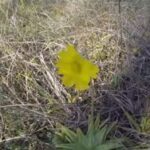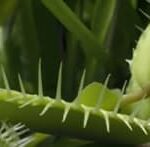As an Amazon Associate, this site earns commissions from qualifying purchases. For more details, click here.
Majority of Mexican butterworts have two types of leaves. The carnivorous summer leaves – which can be succulent or thin – and the non-carnivorous winter succulents. The winter leaves are easier to propagate, but with the right approach you can also do it with summer leaves.
The fastest way to propagate Mexican butterworts is through leaf pullings. Pull off the leaves and place them in a dish or bag with a bit of water in it. Once the plant starts to grow, place it in a soil mix equal parts sand, peat and perlite.
Read Before You Propagate Any Butterworts
If you are going to propagate in late Match or early April, feed your pinguicula first. By this time it would have grown some carnivorous leaves. Butterworts will live even if you do several leaf cuttings or pullings, but it will slow growth. If you want your pinguicula to thrive even with leaf pullings, nourish it. For the best results we suggest Garden Elixir Plant Food as it is very nutritious.
Winter leaf pullings usually have a higher success rate than summer. However summer leaves are bigger. You can strike a balance by propagating in late March or early April in the northern hemisphere.
Method 1 – Leaf Pullings
The following is a step by step guide for leaf cutting butterworts. It works for pinguicula sethos and other tropical butterworts as well.
- Look for healthy leaves on your pinguicula. The bigger the leaves you pull, the higher the chances of success.
- You can cut the leaves with scissors, but pulling by hand will do. Bend the leaf downwards and pull until it snaps off. Repeat for as many leaves as you want.
- Place the leaves in a bag. Spray the inside with water to increase humidity. Close the bag with a clip.
- If the leaves start to decay, keep the bag open. Add more water if the leaves shrink. If the environment has high humidity, place the pullings in an open container. Mist lightly with water if necessary.
- Use mild indoor lighting for the leaf cuttings. Do not expose it to direct sunlight or any type of harsh lighting.
- It might take up to two months before you see a small plant emerge. When it does, move the plant into another pot. Use equal parts peat, sand and perlite for the soil.
- As the ping matures, care for it the same way as the original.
You can try other potting mixes such as vermiculite, perlite and peat. Others like to add dolomitic lime or calcium carbonate sand. You can also use the same potting mix that came with the mother plant if one was included.
Leaf pullings benefit from high humidity. Keep an eye on the leaves and add more water as necessary. You may install a humidifier to increase the moisture level.
Method 2 – Division
Many butterworts like pinguicula weser form multiple rosettes. This is particularly true for flat leaf variants and these are the best candidates for division.
- Remove the pinguicula from the pot. Hold the pot with one hand and place your other hand above the plant. Turn the pot upside down. Shake gently to remove the remaining soil.
- Turn the plant back up. Hold the rosette you want to divide. Look carefully and make sure you are holding all its leaves.
- Twist the plant as if you were twisting a bottle cap. It will pop off.
- Place the original plant back in the pot along with the soil. Increase humidity to 80%-100% to help the plant get over the shock. Slowly bring the humidity level to normal.
- Plant the newly divided rosette in another pot. Use the proper soil potting mix and care for it similar to the original plant.
The most difficult part is not the twisting – the plant comes off easily – but making sure you get all of the plant. If some of the leaves fall off when you pull, you can use those as leaf pullings. Collect those and plant them as described in method 1. Lastly, have the pot and soil ready before you divide so you can plant it as quickly as possible.
Method 3 – Seeds
Propagating Mexican butterworts from seeds take more time. It also takes longer for the plant to grow. But if you want to try this, follow these steps.
- Wait until the flower is about two to three days old. If you cannot get your butterworts to flower, this guide can help.
- Get a fine paintbrush and brush the rear of the flower until it is covered with pollen. Repeat with other flowers if you want. If you have temperate pinguicula, take it outdoors and let the bees pollinate for you.
- Wait for the seeds to grow then gather them.
- Place the seeds in a mixture of perlite, peat and sand. Spread the seeds evenly in a tray, a few inches apart. Make sure the soil is moist.
- Cover the tray with a plastic bag or wrapper. Take it outside under sunlight. Repeat with any other potted seeds you have.
- It will take about 30 days for the seeds to germinate.
Most butterworts grow faster via leaf pullings, but some like p. lusitanica grow faster with the seed method. Once the seeds start growing into plants, you can move it to another pot. You can grow it just like butterworts. You can even fertilize pinguicula for faster growth.
Methods 4 & 5 – LFS and Gemmae
Leaf pullings, seeds and division are the most popular ways to propagate Mexican pinguicula. But there are other techniques you can try. These are applicable only to some species, not all. For beginners, leaf pullings is still the most ideal. Once you have experience you can try these too.
Note on roots: pinguicula have very short, flimsy roots. This makes repotting easy but unsuitable for propagation. Their roots are also prone to rotting so you have to be careful with the soil you use.
Gemmae. P. grandiflora and other butterworts generate gemmae at their winter nestling bud or hibernacula. All you need to do is pull the gemmae from the plant with your hand. You might have to take the plant out of the pot to do this. Once you have the gemmae, sow it. After 4-5 weeks a mall plant will grow.
LFS. Also known as long fiber sphagnum, this works best with non-carnivorous, winter succulent leaves. Whereas summer pinguicula leaves are sticky, these succulents are not.
- Take the plant out of its container carefully. Unlike with the leaf pulling method, you do not need to give it food. The plant cannot eat anyway since its leaves are not carnivorous.
- Use your thumb to remove soil around the rosette.
- Use your fingers to gently loosen and pull leaves off.
- Mix perlite and long sphagnum moss in a container. Drop the leaves there in an upright position.
- Lightly water the soil, careful not too dampen too much.
- Seal the container to keep humidity inside. Within a month you will see results.
A Few Butterworts Propagation Tips
- Once your pullings have grown, water them regularly. Knowing when and how much to water butterworts is essential for growth.
- Butterworts must be well fed to produce healthy leaves and seeds. Small insects, bugs, fish food, mealworms and bloodworms will supply butterworts their required nutrients. These nutrients go directly into the leaves , making them healthier and stronger.
- Some leaf pullings are more successful in spring than winter. With others it is the opposite. Do not be surprised if the results vary.
- You can place leaf pullings and seeds on a petri dish with a damp paper towel on it. This method works well in mid to high humidity.
- Pinguicula gigantea cuttings prefer high humidity and may not grow under dry conditions.
Propagating Mexican butterworts is easier than you may think. As shown here, you have plenty of options and they are all straightforward. So if you have never tried this before, now is a good time to do it.

My fascination with carnivorous plants began many, many years ago with Venus Fly Traps. Now I am more than happy to impart what I know with other enthusiasts and those who are curious about meat eating plants.



